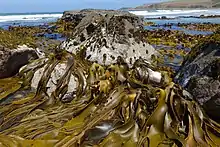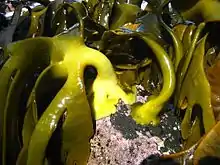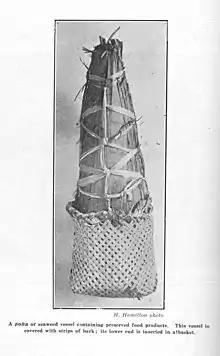Durvillaea poha
Durvillaea poha is a large, robust species of southern bull kelp found in New Zealand.[1][2]
| Durvillaea poha | |
|---|---|
 | |
| Durvillaea poha in foreground (with D. willana below) at Brighton Beach, Otago | |
| Scientific classification | |
| Clade: | SAR |
| Phylum: | Ochrophyta |
| Class: | Phaeophyceae |
| Order: | Fucales |
| Family: | Durvillaeaceae |
| Genus: | Durvillaea |
| Species: | D. poha |
| Binomial name | |
| Durvillaea poha C.I. Fraser, H.G. Spencer & J.M. Waters, 2012 | |
Discovery

The species was previously classified as the "cape" lineage of Durvillaea antarctica,[3][4] but in 2012 it was recognised as a distinct species due to consistent genetic, morphological and ecological differences.[1] In southern New Zealand, D. poha and D. antarctica can be found growing together, although D. poha normally grows higher up or further back on the rock platforms, or in more sheltered bays, where wave force is weaker.[1] D. poha generally has wider fronds than D. antarctica, and can appear more 'orange' across the frond area.[1][2]
Etymology
The specific epithet is from pōhā, storage bags made by Māori out of kelp fronds.[5][6]
Description

The species has wide, air filled blades with a 'honeycomb' structure, and relative stout, pale or orange stipes. The stipes are unbranched.[1][2]
Distribution
The species is endemic to South Island of New Zealand, as well as the subantarctic Snares and Auckland Islands.[1][7]
Human use
Māori culture
Along with D. antarctica, blades of D. poha are used to make traditional pōhā bags, which are used to carry and store food and fresh water, to propagate live shellfish, and to make clothing and equipment for sports.[5][6][8] Pōhā bags are especially associated with the Ngāi Tahu people, and are often used to carry and store muttonbird (tītī) chicks.[5][6]
References
- Fraser, Ceridwen I.; Spencer, Hamish G.; Waters, Jonathan M. (2012). "Durvillaea poha sp. nov. (Fucales, Phaeophyceae): a buoyant southern bull-kelp species endemic to New Zealand". Phycologia. 51 (2): 151–156. doi:10.2216/11-47.1. S2CID 86386681.
- Fraser, Ceridwen I.; Velásquez, Marcel; Nelson, Wendy A.; Macaya, Erasmo C.A.; Hay, Cameron (2019). "The biogeographic importance of buoyancy in macroalgae: a case study of the southern bull‐kelp genus Durvillaea (Phaeophyceae), including descriptions of two new species". Journal of Phycology. 56 (1): 23–36. doi:10.1111/jpy.12939. PMID 31642057.
- Fraser, Ceridwen I.; Hay, Cameron H.; Spencer, Hamish G.; Waters, Jonathan M. (2009). "Genetic and morphological analyses of the southern bull kelp Durvillaea antarctica (Phaeophyceae: Durvillaeales) in New Zealand reveal cryptic species". Journal of Phycology. 45 (2): 436–443. doi:10.1111/j.1529-8817.2009.00658.x. PMID 27033822. S2CID 18309093.
- Fraser, C.I.; Winter, D.J.; Spencer, H.G.; Waters, J.M. (2010). "Multigene phylogeny of the southern bull-kelp genus Durvillaea (Phaeophyceae: Fucales)". Molecular Phylogenetics and Evolution. 57 (3): 1301–11. doi:10.1016/j.ympev.2010.10.011. PMID 20971197.
- "Page 4. Traditional use of seaweeds". Te Ara: The Encyclopedia of New Zealand. 12 June 2006. Retrieved 19 November 2019.
- "Traditional Māori food gathering". Museum of New Zealand Te Papa Tongarewa. Retrieved 21 November 2019.
- Parvizi, Elahe; Fraser, Ceridwen I.; Dutoit, Ludovic; Craw, Dave; Waters, Jonathan M. (2020). "The genomic footprint of coastal earthquake uplift". Proceedings of the Royal Society B. 287 (1930): 20200712. doi:10.1098/rspb.2020.0712. PMC 7423469. PMID 32635859.
- "Maori shellfish project wins scholarship". SunLive. 13 May 2018. Retrieved 26 November 2019.
External links
- Algaebase: Durvillaea poha C.I.Fraser, H.G.Spencer & J.M.Waters
- Museum of New Zealand Te Papa Tongarewa: Durvillaea poha C.I.Fraser & J.M.Waters (Species)
| Wikispecies has information related to Durvillaea poha. |
| Wikimedia Commons has media related to Durvillaea poha. |
